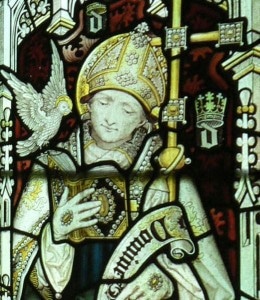 Today is the feast day of St David (Dewi Sant), patron saint of Wales. According to Rhigyfarch’s “Life of Saint David”, David lived in the 6th century and founded religious centres including Glastonbury and Croyland. He then travelled to the Holy Land and was made archbishop at Jerusalem before travelling back to Wales and settling at Glyn Rhosyn, or St David’s. There, he founded a monastery whose site is now marked by St David’s Cathedral.
Today is the feast day of St David (Dewi Sant), patron saint of Wales. According to Rhigyfarch’s “Life of Saint David”, David lived in the 6th century and founded religious centres including Glastonbury and Croyland. He then travelled to the Holy Land and was made archbishop at Jerusalem before travelling back to Wales and settling at Glyn Rhosyn, or St David’s. There, he founded a monastery whose site is now marked by St David’s Cathedral.
Dewi and his community were said to have performed many miracles which included Dewi causing the ground to rise beneath him while preaching at the Synod of Llanddewibrefi so that everyone could see him.
Dewi died in 589 and was recognised as a Catholic saint in 1120. His feast day, 1st March, is now no longer a religious feast but is a national celebration of Wales and Welsh identity. It is traditional for Welsh people to wear a daffodil or leek on 1st March, and the leek as a symbol of Wales is linked to two legends:
- The legend of the soldiers of the ancient British king, Cadwaladyr, wearing leeks so that they would know who their comrades were in battle.
- The legend that the Welsh archers fought in a field of leeks at the Battle of Crécy when Edward, Prince of Wales, defeated France. It was said that Welshmen then wore leeks on their caps on St David’s Day to remember the courage of the archers.
W. Carew Hazlitt, in the book “Faith and Folklores”, writes of how Henry VII “having Welsh blood in his veins” felt particularly obliged to observe the feast day and records show that he paid £2 one March for a feast for Welshmen. According to the Privy Purse Expenses of Henry VIII’s daughter, Princess Mary, she was presented with a leek by yeoman of the guard on the feast day in 1536, 1537 and 1543.*
Notes and Sources
*The gifts to the yeoman guard for bringing the leek are dated 1536, 1537 and 1543 but those are old style, with 1st March being before the Tudor New Year on Lady Day (25th March), so we’d actually refer to these dates as 1st March 1537, 1538 and 1544.
- Museum of Wales
- Why do we wear daffodils and leeks?
- Faiths and Folklores, W. Carew Hazlitt
- Privy purse expenses of the Princess Mary, daughter of King Henry the Eighth, afterwards Queen Mary, ed. Frederick Madden